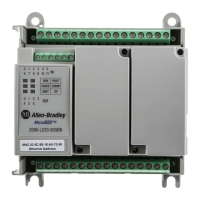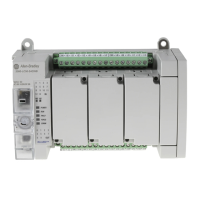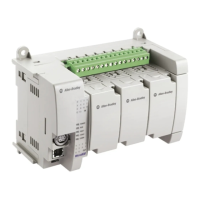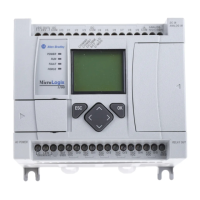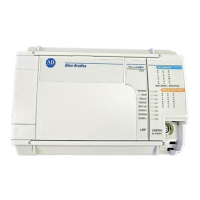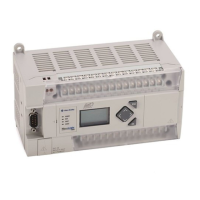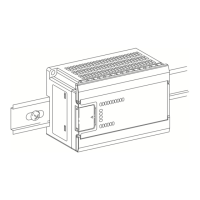Proportional Integral Derivative (PID) instruction Chapter 20
Rockwell Automation Publication 2080-RM001D-EN-E - February 2015 577
Auto-tune parameters
The following table describes the variables that are used with each parameter in
the example to configure auto-tuning.
Input parameters
Variable Parameter Description
AutoMode Auto The operation mode of the PID controller:
TRUE - controller runs in normal mode.
FALSE – derivative term is ignored forcing the controller output to track the feedback within the
controller limits, and allowing the controller to switch back to auto without bumping the output
Initialize Initialize Initializes AutoTune sequence.
A change in value from TRUE to FALSE or FALSE to TRUE causes the controller to eliminate any
proportional gain during the cycle.
My_Gains Gains Establishes the Gains PID for IPIDController.
My_Gains.DirectActing DirectActing Defines the type of acting for the output.
TRUE - direct acting in which the output moves in the same direction as the error. That is, the actual
process value is greater than the SetPoint and the appropriate controller action is to increase the
output. For example, chilling.
FALSE - reverse acting in which the output moves in the opposite direction as the error. That is, the
actual process value is greater than the SetPoint and the appropriate controller action is to decrease
the output. For example: heating.
My_Gains.ProportionalGain ProportionalGain Proportional gain for PID (>= 0.0001).
My_Gains.TimeIntegral TimeIntegral Time integral value for PID (>= 0.0001).
The tendency for oscillation increases with a decrease in ti.
My_Gains.TimeDerivative TimeDerivative Time derivative value for PID (> 0.0).
Damping increases with an increase in derivative time, but decreases if the derivative time value is too
large.
My_Gains.DerivativeGain Derivative gain for PID (> 0.0).
AutoTune When set to TRUE and Auto and Initialize are FALSE, the AutoTune sequence is started.
ATParameters
Load
Initial output value during auto-tuning.
• Allows the process value to stabilize at the load
Deviation
• The standard deviation for a series of stabilized process values. For example, if the process value stabilized between 31.4 to 32.0,
then the deviation value would be (32.0-31.4)/2 = 0.3.
• Some process values, such as temperature, take a very long time to stabilize.
Step
• The auto-tune process considers how the process value reacts to the changes in step value and derives the Gain parameters.
ATDynaSet
Allocated time for the auto-tune to complete. It must be longer than what is required for the auto-tune process.
• A common value for many systems is 600 seconds, but some systems may require more time.
ATReset
If TRUE, the output will be reset to "0" after auto-tune completes.
• If FALSE, the output will remain at the load value after auto-tune completes.
Output parameters
Parameter Description
AbsoluteError Absolute error (Process – SetPoint) from the controller.
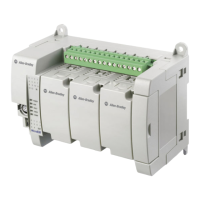
